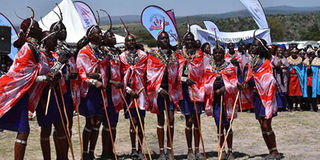Plaudits as Nairobi hosts forum, though long road still lies ahead

Morans from Loita Maasai perform at Olmesutie, Narok County, during the International Day of Zero Tolerance for Female Genital Mutilation on February 6, 2019. Kenya has committed to eradicating female genital mutilation by 2022. PHOTO | FILE | NATION MEDIA GROUP
What you need to know:
- Universal access to quality, affordable comprehensive sexual and reproductive health services in primary healthcare and education matters.
- EU contributions just to sexual and reproductive health and rights, and against sexual and GBV, have amounted to over €1 billion in 2014-2020 globally.
It is not often that the figure ‘0’ is associated with high achievement.
So why is it that the UNFPA, inspired by the 179 governments that met in Cairo in September 1994 for the first International Conference on Population and Development, chose to associate no less than three major goals with this most unpromising of figures?
There is zero unmet need for family planning; zero preventable maternal deaths; zero gender-based violence and harmful practices against women, girls and youth.
There was a common understanding among the diverse countries that the practices that undermine and do significant harm to women, girls and young people belong to the past.
Alas! They were ubiquitous and, in spite of the progress, in many places still are.
It is not that the 179 governments lacked ambition; they realised how far removed the reality was from their goals.
COMMENDABLE STRIDES
Significant gains have been made in the implementation of the Programme of Action of the ICPD and the Beijing Platform for Action, which have led to a better state of sexual and reproductive health and rights for females in many areas.
For example, Kenya has just committed to incrementally increase its budget on health to 15 per cent and its social protection investment from 0.8 per cent of GDP to at least two per cent over the next 10 years.
It has also committed to eradicating female genital mutilation by 2022.
However, globally, gains are unequally distributed and, in the most marginalised communities, women, girls and young people are often worse off than they were 25 years ago.
In Kenya, there are stark regional inequalities in health infrastructure between urban centres and the more marginalised areas.
RISKS
In many countries, vulnerable groups have been affected by natural or man-made disasters in which their basic needs are the first to be neglected.
Think of the many refugee girls being married off early or forced into prostitution to reduce the burden on families.
Or the limited or non-existent access to safe family planning when the healthcare system collapses during natural disasters and the sanitary dangers women are then exposed to when they give birth.
Or how corruption eats into the resources that should go to women, girls and youth.
These vulnerable groups are at the sharp end of the consequences and are more likely to be out of school and face risks such as early pregnancy, child labour, trafficking and sexual and gender-based violence.
SOCIETY'S RECOVERY
Universal access to quality, affordable comprehensive sexual and reproductive health services in primary healthcare and education matters.
In view of the demographic shifts that lie ahead, policy responses are needed for the challenges of our times — fertility, ageing, urbanisation, migration and displacement, and the need to ensure labour, health, education and pension systems are optimally located and funded.
Although the European Union and its member states face many economic and social challenges in this domain, it has brought an unprecedented degree of stability, good governance and peace in Europe in the past 60 years.
With its conflict-prone past, the EU understands the need to help those suffering in conflicts.
There is the recognition that recovery from conflict, followed by good governance, comes through the recovery of society as reflected in the well-being of women, girls, and young people who are a country’s future.
FINANCING
EU contributions just to sexual and reproductive health and rights, and against sexual and GBV, have amounted to over €1 billion in 2014-2020 globally.
This commitment will remain as strong — perhaps stronger — in the EU’s next funding cycle 2021-2027 as it has been so far.
Never has the achievement of the three zeros looked as attainable as now.
Our aim is to achieve the most evident of baselines for our civilisations — to meet the basic rights of women, girls and young people.
Mr Mordue, the European Union ambassador to Kenya, and 17 ambassadors of EU member states in Kenya. [email protected]




